Capillarisation and The Importance To Rock Climbing Performance
Capillaries are an important physical feature of the body – more on that shortly – that climbers, especially route climbers, inadvertently obsess about. When I say inadvertently, I mean that they’re constantly thinking about how they get fitter by way of better endurance and recovery, yet they hardly ever realise that what they’re specifically thinking about is the role our capillaries play in our muscular endurance and how this relates to performance. The reason why capillaries are key to muscle function and exercise capacity, is that they are central to the delivery of oxygen and nutrients and removal of metabolites and carbon dioxide.
Outside of climbing, research has found that 98% of the variance in critical power (a great benchmark for a muscle’s level of aerobic ‘fitness’) can be explained by the capillary to muscle fibre (C:F) ratio in relevant exercising muscles. The C:F ratio describes the amount of contact points that the capillaries have in relation to the number of muscle fibres. The higher it is, the better the aerobic performance of the muscle. The reason for this is that capillaries are the ‘end point’ of delivery of oxygenated blood to the muscles. Oxygen is the terminal electron acceptor that makes up part of the lengthy process that is the aerobic pathway, and as such the greater the supply of oxygen the greater the output of ATP via aerobic metabolism.
Before looking at what happens when capillarisation (often referred to as angiogenesis in the literature) occurs and how we can affect it through training and exercise, let’s have a look at the basic physiology.
Physiology
Capillaries are a single layer of simple epithelium cells, which do not have the muscular or elastic nature of other blood vessels (arteries, veins etc). They’re smaller and have thinner membranes, allowing fast gaseous exchange and transmission of water, fats and proteins. They are essential for the exchange of gases (delivery of oxygen and removal of carbon dioxide), nutrients and metabolites to the muscle, which means that they have a significant impact on exercise capacity.
The presence of higher density muscle capillaries means a larger blood-to-muscle exchange surface area, which in turns allows for faster exchange of exercise-limiting factors such as oxygen and carbon dioxide transmission. The growth of these capillaries is termed ‘angiogenesis’ and as such, any factors increasing this are known as ‘angiogenic factors’ and those which prevent it are known as ‘angiostatic factors.’ During exercise endothelial growth factor (VEGF) is secreted, which is the primary driver of angiogenesis and at present it is believed that this remains the most effective factor involved in increasing C:F ratios in the muscle.
How Does Exercise Affect Our Capillaries?
The effect of exercise on angiogenesis is still an area of research requiring much more work, but at present it is understood to involve both metabolic (change in tissue oxygen and nutrient levels) and hemodynamic signals (shear stress and passive stretch). The mechanical signalling of shear stress (literally the friction of the red blood cells rubbing against the capillary walls) and stretching (the capillary being stretched as red blood cells pass through it) causes new capillary growth via either longitudinal splitting and sprouting. This process ultimately increases C:F ratios. In untrained individuals increases in capillarisation of 10-30% are observed after 6-8 weeks of training and elite athletes with years of consistent endurance training demonstrate a C:F ratio two times greater than that of untrained subjects.
Oxygen uptake from a resting muscle is 1 ml O2/min per 100g of tissue and may increase up to 30-fold during high intensity exercise, which will be benefited by higher levels of capillarisation. This extreme range and change in oxygen transmission is supported by the low diffusion distance and large diffusion area of the capillaries in the muscle.
In terms of the effects that varying training modalities have on capillarisation, the research at present points practitioners in two key directions when it comes to the performance levels of their athletes. Firstly, in untrained athletes or those of low training status exercise has a positive (if somewhat limited) angiogenic effect via a broad range of submaximal and supra-maximal resistance training, classical endurance training and even passive leg extensions. However, there is a notably limited effect with these modalities in well trained athletes. When it comes to the elite, athletes will likely respond best to a specific regimen of low intensity, high volume training. One early study observed a 28% increase in C:F ratio following a 24 week low intensity/high volume endurance training program and subsequent studies have confirmed the strong effect of this approach.
Despite this clear pattern of positive response to high volume, low intensity training, when it comes to angiogenesis, we should not ‘throw out’ other forms of higher intensity endurance work such as interval training. The improvements in enzyme function, mitochondrial biogenesis and cardiac remodelling are still positive ‘forces for improvement’ for athletes interested in fitness and localised aerobic output. It is critical to understand that both forms of exercise modality (low intensity/long duration and interval) have their pros and cons but if a climber wishes to specifically work on capillarisation it will be most effective under the conditions provided by long duration, low intensity training.
Finally, as an interesting footnote to this section, some researchers have noted that the angiogenic response is not entirely limited to active exercise. More than one study has observed VEGF secretion and consequently significant increases in blood flow (2.8x in one study) with 90 minutes of passive leg movement. Unfortunately, the effect appears somewhat transient and without chronic stimulus the sport-specific benefits may be limited. However it does demonstrate that even a very low intensity stimulus can be beneficial in terms of increased capillarisation.
How Should Climbers Work On Capillarisation?
Like many areas of current research, we still lack climbing-based studies which means that some assumptions have to be made and little is certain. Where we can have some confidence in our approaches, is in the combined observation and understanding of the literature, our own findings in athlete response to training methods and experience as evidence-based sports practitioners. In other words, it’s a combination of theory, research and experience!
1. Capillarisation matters: We have a high confidence that Critical Power (CP) is a key determinant in route climbing performance (see our work on Digital Testing). We know that research places a very high statistical explanation (98%) of CP on the capillary-to-muscle fibre contact ratio. A higher CP results in better aerobic ATP production, intermittent recovery during exercise efforts and slower ‘burn’ through anaerobic work capacity at a given exercise/route intensity due to the greater ability of the aerobic system to be able to contribute at higher exercise intensities.
2. Duration matters: The angiogenic factor of shear stress appears to correlate strongly with duration of blood flow at a lower intensity. Climbers should likely concentrate on completing endurance training in intervals (and total session lengths) sufficient in duration to maximise the shear stress effect. However, some attention should be given to the potential negative effect on further training or recovery if duration is excessive. As research suggests that the stimulus for increased capillarisation does not increase with intensity, but instead scales with duration, a practical solution is to perform endurance exercise at a very low intensity to maximise duration while not inducing excessive fatigue. This ensures that the endurance training sessions do not compromise the high intensity training sessions which are key for other key elements of performance.
3. Intensity matters: Whilst research has found increases in capillary growth as the result of passive exercise, resistance training and supra-maximal strength training, the effects are either limited in duration or only provide a weak stimulus for growth in well trained athletes. Climbers should complete endurance training well below critical power and at a level that increases blood flow to promote shear stress. Our current guidelines would recommend this being at around 6 grades under your current onsight level. In periods of training focused on capillarisation, high intensity training should be limited/tightly controlled due to release of anti-angiogenic factors when this form of training is completed.
In summary, what we class as ARC or continuity training is likely to be the most effective form of training for capillarisation. Training strategies should aim to include this form of training into periodised cycles of ‘blocked’ work that allow for maintenance of strength training and adequate recovery from sequential training days. This is not necessarily a ‘more is always better’ form of exercise and as such a balanced approach should be applied depending on the overall needs and training history of the athlete.
Further reading:
1. Invited review: activity induced angiogenesis, Eggington (2009)
2. Capillary growth in human skeletal muscle: physiological factors and the balance between pro-angiogenic and angiostatic factors, Hellsten & Hoier (2014)
3. Intense intermittent exercise provides weak stimulus for vascular endothelial growth factor secretion and capillary growth in skeletal muscle, Hoier et al
4. Growth of capillaries in skeletal and cardiac muscle, Hudlická (1982)
5. VEGF, shear stress and muscle angiogenesis: a complicated triangle, Banfi & Gianni-Barrera (2015)
6. Effect of high intensity training on capillarisation and presence of angiogenic factors in human skeletal muscle, Jensen et al (2004) 7. 10-20-30 training increases performance and lowers blood pressure and VEGF in runners, Gliemann et al (2015)
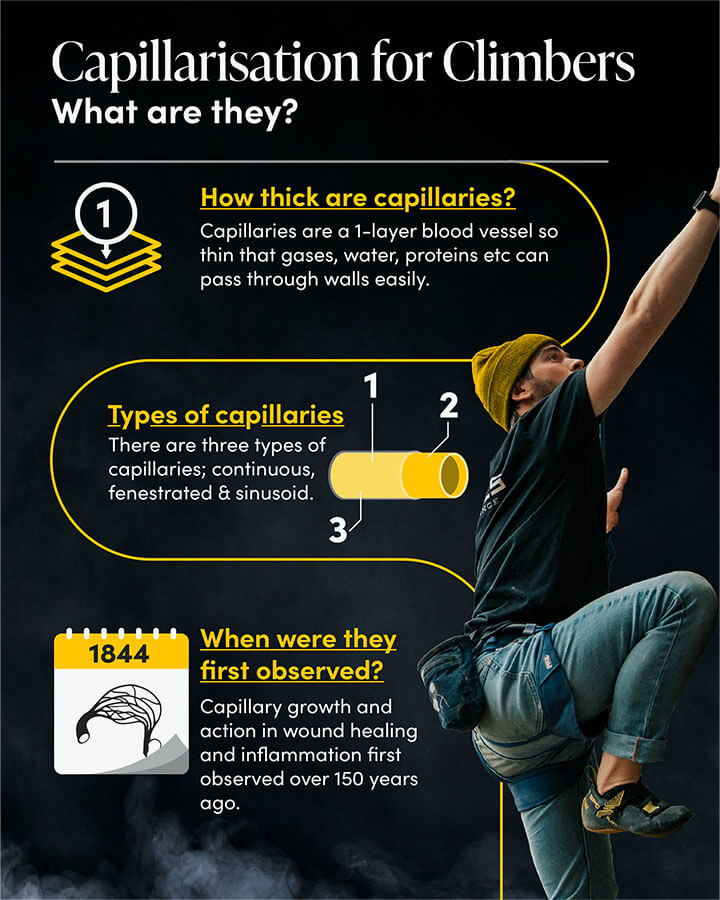
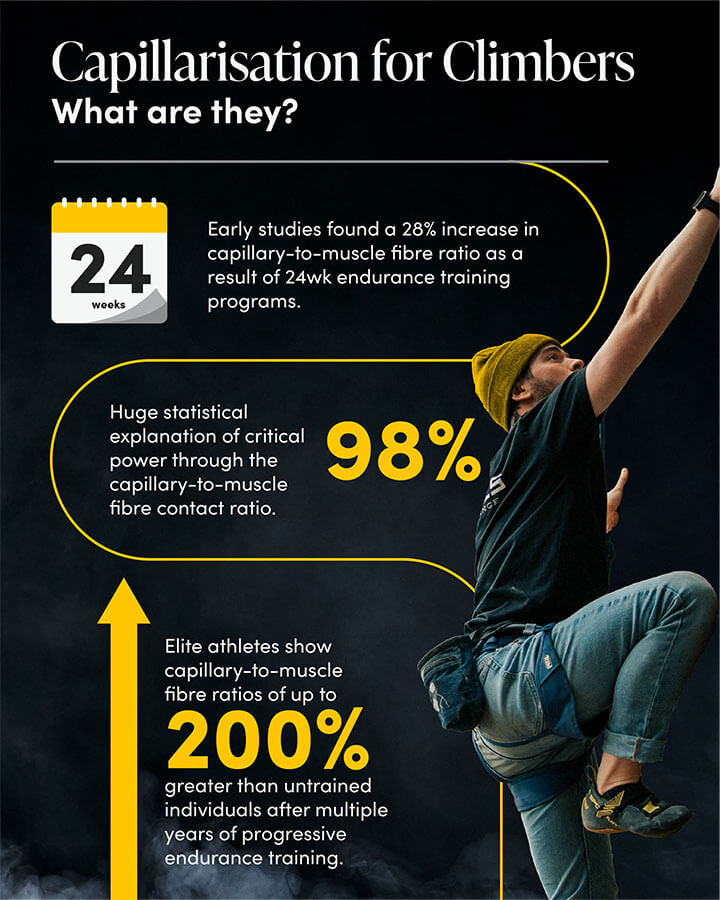
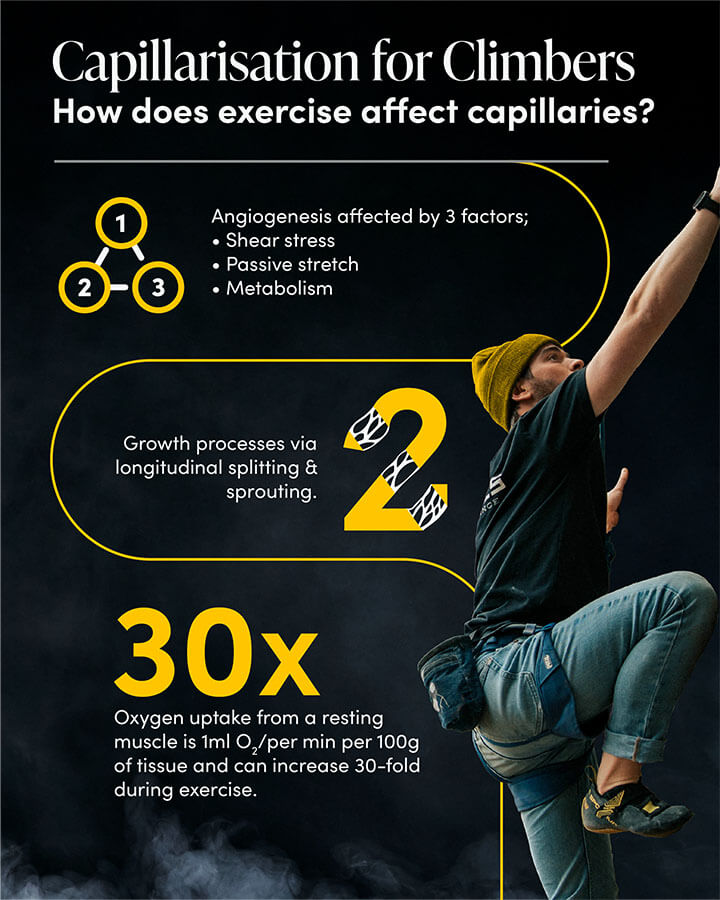
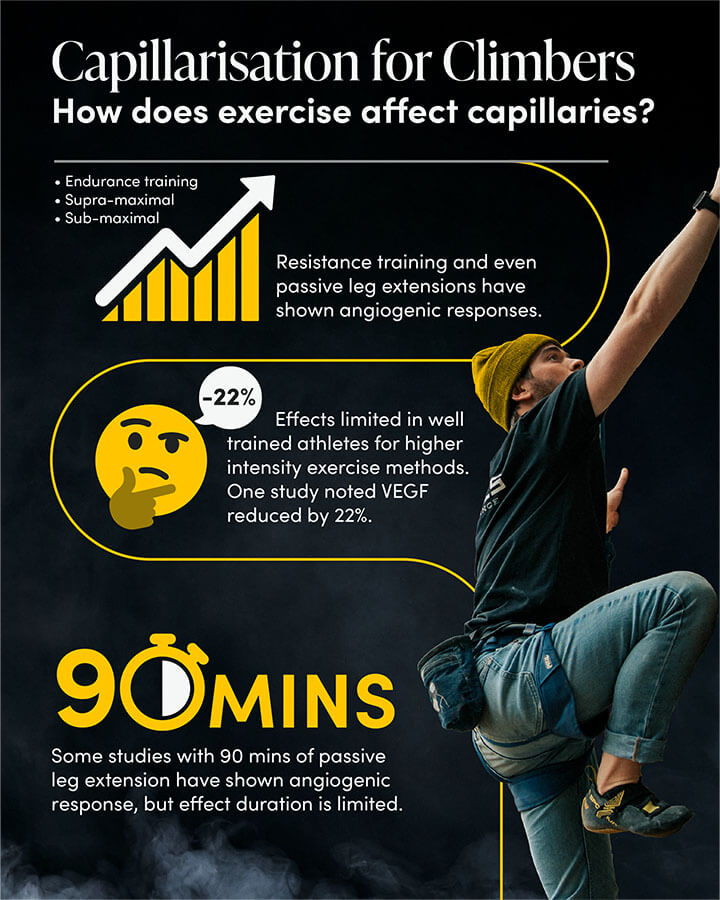
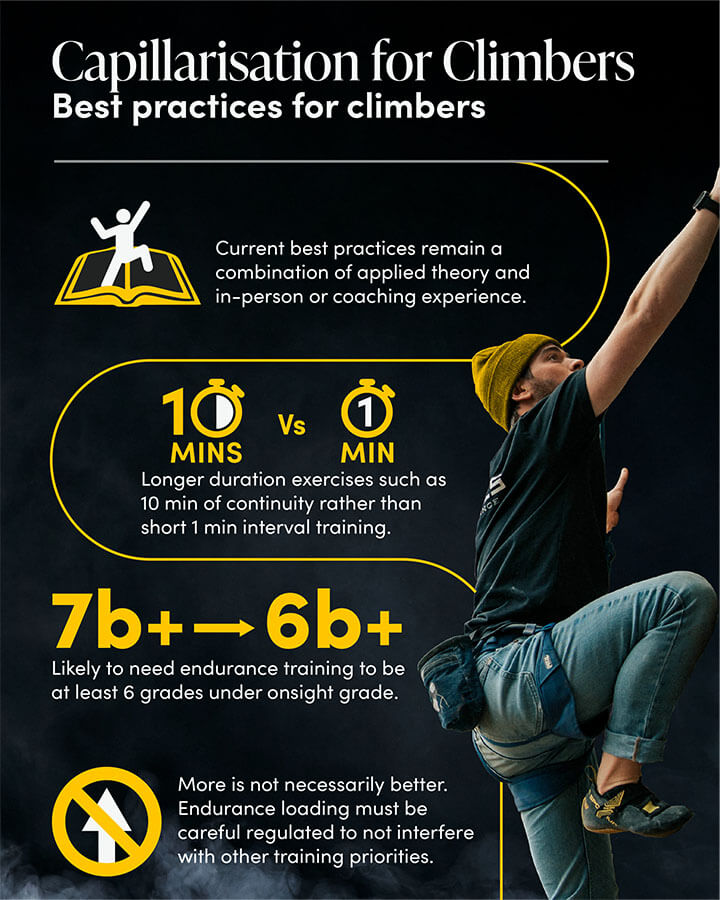






Great article and great research. Do you all have a bibliography or list of relevant research articles related to climbing?
I love the focus on base endurance here. I have a unique perspective of coming to climbing from an elite background in cross country skiing as well as running. I think that there are more similarities between sport climbing and the 1500-5000m distances in xc skiing and track than most people would guess.
In these 4-15min duration efforts, the high perceived effort makes people feel that the energy system contribution is mostly anaerobic. However, the aerobic system is still the primary contributor, especially in elite athletes. When looking at xc skiing, world cup level sprinters train almost identically to distance athletes. Ranging from 500-900h of training volume per year, roughly 85-90% of that time is spent going incredibly slowly. Although climbing does not engage cardiac and pulmonary systems to the same degree, the capillary and intracellular systems are similarly engaged.
I think taking some cues from these well-established sports can be helpful in improving climbing training regimens. First, gradually increasing training volume over time is important. There are copious examples of junior athletes who become national-class quickly by jumping their training volume to ~700h/year, but then fail to progress thereafter. The international-class athletes almost invariably are training less at age 18, then add aerobic base volume throughout their 20s and 30s. I would propose starting at 1-2h/week of endurance work climbing if you’ve never done it before, then increasing by roughly 0.5-1h/week each year thereafter as a general rule.
The second big one is that in skiing a single 2h aerobic session is typically preferable to four 30m sessions. When glycogen stores become relatively depleted, aerobic energy increasingly comes from lipid oxidation. I don’t know the physiological reason why, but it is generally accepted that this somehow increases angiogenesis. Perhaps glycogen depletion also diminishes anaerobic pathways, so the second hour of continuous exercise has a higher percentage contribution of aerobic energy production. One big caveat for climbing though is skin. Two hours doing laps on a spray wall would definitely build a pretty big skin deficit!
I’m applying some of these principles to my training this year. The goal is a jump from 12a to 14a in my 2nd real year of climbing. We’ll see how it ends up. So far so good just 3 months in!
Interesting article. Given that duration and low intensity exercise seems to be the key, which maybe boring down the gym. How about sitting at home watching a movie, with a squeezy ball in each hand, and repeatedly squeezing them, throughout? This might be an easy addition to training.
Interesting article. I’m quite new to sports science but I am finding the area of physiological adaptations to climbing very fascinating! I have often read/heard the advantages of high volume and low intensity training, but this article really helps me understand the mechanisms a bit better. I appreciate the reference list at the end as well. If I could suggest one little thing, is if you could add citations throughout the text in the future, as it would make it easier to check specific pieces of research. For example: the study that finds a 98% of variance explained in critical power, which is pretty insane and makes me want to check out their data analyses!
There are two problems i face with this type of training. First, it is very boring:) And second, and maybe more importantly, it is hard to do it in a crowded gym.
My question is, does it work with a fingerboard with reduced load (like feet on the floor, just pulling with fingers and shaking hands occasionally)?
Interesting article indeed. I have been following the research on endurance training and angiogenesis quite well. It is good to know that my line of thought is in line with what you guys are writing here. I do have some additional ideas, and I am quite curious to hear your thoughts about them.
In the angiogenesis research moderate intensity continuous training (MICT), high intensity interval training (HIIT) and sprint interval training (SIT) are often compared. When volume is equated, MICT seems to have a similar or slightly better angiogenic effect (depending on the study) when compared to HITT. When we assume accumulated friction at the capillary wall is most important for stimulating angiogenesis, I think these findings still make sense. In HIIT I can imagine the amount pressure and flow in the capillaries is not that different compared to MICT. Especially when active rest is being used. What is probably more important than the type of intervention being used (HIIT vs MICT), is the total volume of training. This is where MICT Shines. It has a better stimulus to fatigue ratio, which means more volume can be done with less risk of injury and/or overtraining. Although in climbing there is potentially a bit more occlusion happening due to the nature if isometric contractions, I can still imagine the same story would more or less apply.
When talking about climbing, ARCing for me is the same as MICT. I consider The use of MICT for sport climber to be really important. I think we can both agree here. I have seen you advising the same for boulder specialists (although with less total weekly volume). I am not sure if this is optimal from both a practical view point, and maybe unneccesary or even suboptimal from a stimulus point of view. My alternative would be an continuous bouldering circuit. Which means, when you have climbed a boulder you immediately walk to next boulder of the same grade. The key here is to select a bouldering grade which allows you to get no or barely noticeable pump in the forearms. Because bouldering grade is not maximum and metabolite build up is not high, I would assume the angiogenic stimulus to fatigue ratio is probably not that much worse compared to MICT. The duration of these sessions can be similar to what you would do for MICT. The upside here is:
– The athlete does not need a climbing partner for belaying
– A simple to use protocol with no needs for timers and difficult explanations
– You can use just one gym
– Velocity and intensity of movement is higher, which allows potentially better maintenance of power and strength in prime movers
– A slightly better stimulus for mitochondrial functioning
What do you think? Do we really have to be very restrictive with our angiogenesis style training?
Hi Syste, Tom R here 🙂
I always enjoy reading your ideas (and background research) and you pose some interesting questions. With regards to HIIT vs MICT then you’re quite correct in the sense that MICT should generate a better angiogenic response. As you state, the total time under which you have the increased blood flow (and associated shear stress factor) is a big determinant, rather than intensity.
Your suggestion of a moderated MICT via continuous links of (easy) boulders is a decent one and I don’t see why this shouldn’t work. As you say, there’s some really practical benefits. I would suggest that the main things people would need to watch out for were:
1. Movement pace doesn’t become out of line with how they actually route climb. Move too fast in training all the time and you can’t replicate it on the route outside = an issue.
2. There’s a bit of a temptation to go a bit too hard when having complete rests between boulders, rather than the continuous nature of climbing that you get with ARC/continuity, so the climb would need to be VERY disciplined about grade selection
3. I’m not totally convinced about the mitochondrial stimulation across the whole muscle type spectrum – in my opinion this is easy enough to achieve via other training modalities and could be just chasing a white rabbit as such.
4. Lastly IF anyone is reading this and wants to try it, do NOT jump down from each boulder…. I did this many years ago and after jumping off the top of 80+ boulders in a session, my legs were destroyed for about a week, ha!
Hi Gunter, it might just be a perception thing, but we most definitely are very ‘pro’ ARC/continuity training! You’ll see it feature a lot in our athletes plans too…
Ultimately it comes down to a ‘volume first’ approach, so 40 mins will give a better return than 10 or 20 mins. Do remember it MUST be low intensity though!!
Maintenance should be ideally be a minimum of 1x week, but potentially higher for elite athletes.
One thing to one aware of is that 10hrs isn’t necessarily better for you IF your training loads/history aren’t compatible. Build up over time and look at testing protocols like the critical force testing we do, to track baseline changes over the years.
Hope that helps!
Tom R
A few questions about this: aside from the opportunity cost of time spent doing this type of training, is there a trade off between capillarization and strength? I also noticed that the traditional really long ARC sessions don’t feature heavily on the crimpd app or in the material you guys release, yet those long ARC sessions are the workouts that follow most naturally from what you’ve written here. Are aerobic capacity workouts like 20 minutes of 1 on 1 off as effective as, say, a 40 minutes ARC session, or are they just more approachable? How consistently do you have to keep up this type of training to maintain your capillaries once you’ve developed them? Is there a limit to how much volume is beneficial, or is more better when it comes to capillarization (i.e. will 5 hours on the wall per week get you the same gains as 10 hours)?
Hi Gunter,
Tom R has replied to your questions above 🙂